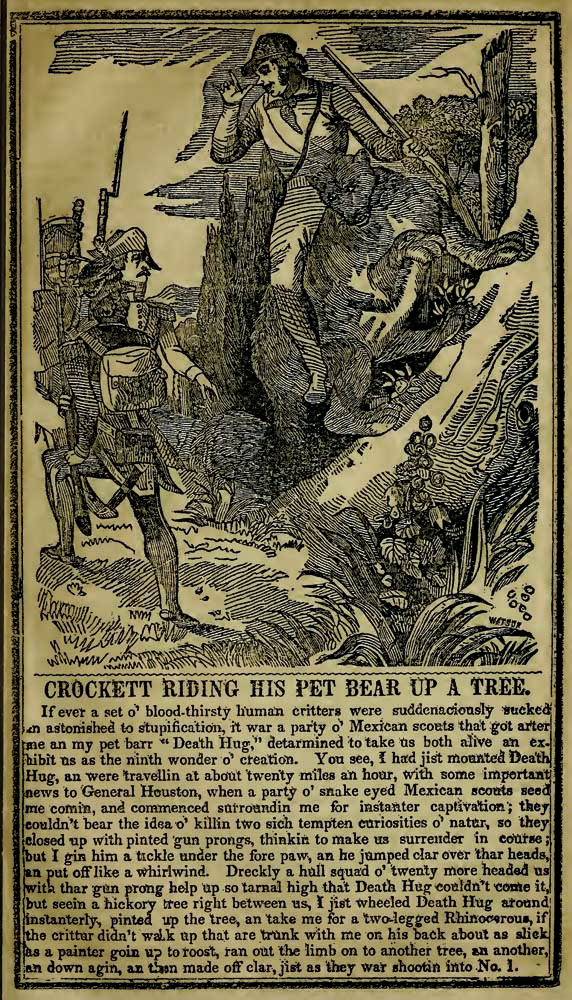Offbeat Oregon: Helicopter crash had huge impact on Portland journalism
Published 12:00 am Wednesday, February 21, 2018

- An illustrated story of Davy Crockettís escape from Mexican soldiers on his pet bear, Death Hug. (submitted photo)
A few days before Christmas in 1947, a young ex-Navy flier, looking to kill a little time before dinner, invited a friend to come out for a quick spin around a nearby golf course in his new helicopter.
An hour later, the two young men were both dead in the burning wreckage of the helicopter, and the future course of journalism in Portland had been forever changed — and not for the better.
At the end of the Second World War, the Portland Journal had never been in a better position. Its main competitor, the Morning Oregonian, was still technically larger; its circulation was just over 200,000, while the Journal’s was just under that figure. But the Oregonian’s influence was waning and its reputation still suffered a bit from the way it had shamelessly spun its news reports back in the 1910s and 1920s.
Arguably the most important asset the Journal had, though, was Associate Publisher C.S. “Sam” Jackson II, the grandson of the newspaper’s legendary founder and the newspaper’s heir apparent.
Sam Jackson’s grandfather, Sam Jackson I, founded the Journal in 1902 at a time when Oregon was essentially run out of smoke-filled rooms by a coalition of power brokers consisting of the Oregonian, the lumber barons, and the Southern Pacific Railroad.
Everyday Oregonians, especially Democrats, had to hold their noses and read it, because there was nothing else available.
Alternatively, they could read the smaller, less informative Evening Telegram, which, although owned by the Oregonian, was staffed with an independent newsroom housed in a separate building and which generally appealed to the populist wing of the Republican and, to a lesser extent, Democratic parties.
Jackson threw a monkey wrench into this cozy pseudocompetitive arrangement when he moved to Portland from Pendleton, where he’d published the East Oregonian newspaper, and took over a moribund little startup newspaper called The Oregon Journal. Under Jackson’s direction, the Journal became the most trusted newspaper in the city, even among conservative Republicans — although Republicans tended to hate its editorial positions; Jackson was originally from Virginia, and very much a Democrat.
Time went by and the Journal moved from strength to strength. It was a scrappy, active paper, taking bold positions against monied interests time and again — in the “pure milk crusade” when Portland babies were dying from tainted milk, in the fight to stop the timber and railroad barons who were illegally taking over huge tracts of public timberlands, and in the push for the Oregon Initiative and Referendum system.
Sam Jackson died in 1924, and his son, Philip Jackson, took the reins. Philip was competent and satisfactory as a publisher, and ran the paper for 29 years. But most people agreed he didn’t have the magic touch that his father had.
Philip’s nephew, though — he was another matter. Named after his grandfather, Sam Jackson II was a graduate of Lincoln High School in Portland. He went on to study at Stanford and Harvard, and learned to fly; then, when the war broke out, he joined the U.S. Navy, trained Navy pilots, and flew missions in the Pacific Theater, mustering out at war’s end at the rank of lieutenant commander.
Sam was more than a little reminiscent of his grandfather. Great things were expected of him when it came to be his turn to run the family business.
And so matters stood in 1946, when Philip Jackson saw an advertisement for the new Bell helicopters.
Philip was captivated by the possibilities. Helicopters were a brand-new thing in 1946. The first helicopter built for civilian use, the Bell 47B, had just come out, a tiny two-seater that looked rather like a Fiat 500 with a tail and a rotor. They were selling for $25,000 apiece. Wouldn’t it be neat if the Journal were to buy one, and use it to get photographs of breaking news stories?
Sam, who by this time had about 2,000 hours of flight time under his belt and was one of the best pilots in Portland, took the idea and ran with it. And so, in April 1947, a spindly green helicopter with “JOURNAL” stenciled on its tail set down for the first time on the roof of the Journal’s building downtown.
The helicopter was a sensation. It was the first news helicopter in the country. All summer long, Sam flew it around Portland. When news broke, he’d run for the chopper with a photographer and go get the story, with pictures the Oregonian couldn’t match — usually with a little logo at the bottom right reading “Journal Copter Photo.”
Probably the high point of the Journal’s triumph was when a fire broke out in the Oregonian building, and they were able to fly over and get aerial photographs of their rival’s building with smoke billowing out of it.
By the end of the year, the Journal’s little eggbeater was a familiar sight in Portland, and the Journal had prepared a picture book full of images it had captured. They titled it “The Newsroom Dragonfly.”
But before it could be published, came the evening of Dec. 21, 1947.
Sam Jackson had flown the helicopter to the home of his friend Ambrose Cronin — who was, ironically enough, a grandson of former Oregonian publisher Henry Pittock — where he had been invited for dinner. He arrived a little early, so Jackson invited Cronin to come up for a quick spin around the neighborhood.
The two of them flew out over a nearby golf course while other dinner guests watched. Then, reaching the other side, Jackson apparently tried to turn too quickly.
The dinner guests and family members watched in horror as the helicopter, with the scions of two newspaper empires aboard, stalled and dove 100 feet into the ground, where it bounced once and burst into flames.
What the impact of the loss of Cronin might have been on the Oregonian isn’t clear; his main commercial activities were outside the newspaper business.
But the effect on the Journal was disastrous. There was now no Jackson family member in line to take the helm.
So when, six years later, Philip Jackson died of heart trouble, the only surviving members of the family were Sam Jackson I’s widow, Maria, and Sam Jackson II’s 11-year-old son, Peter. So it was necessary to look outside the family circle for a publisher. William Knight, the newspaper’s attorney, was tapped for the job, and the newspaper’s ownership was put into a trust. Maria stipulated that if it were ever necessary to sell the paper, it must be to a local owner, preferably to the paper’s employees, even if an out-of-towner offered more money.
She probably was thinking of one out-of-town owner in particular: S.I. Newhouse of New York, who had bought The Oregonian in a distress sale after it had financially crippled itself trying to build a big deluxe new office building. Newhouse wanted the Journal badly, and everyone knew it.
Well, the story of how Newhouse got his wish as an effect of an extended strike by the stereotypers’ union has been told before in this column. Newhouse was either very lucky, incredibly clever, or both; but by 1961, Maria had been dead for several years, and the Journal’s trustees sold out to him for the astonishingly modest sum of $8 million, or about $67 million in modern currency.
After that, with Knight still at the helm, the Journal basically took over the role that the Evening Telegram had filled four decades earlier: a junior paper, fully owned by the Oregonian, with a separate and competitive newsroom (but now on a different floor rather than in a different building). The news departments competed with each other, but the Oregonian got more resources with which to compete, and the reading public wasn’t really fooled. In most respects, Portland was now a de-facto one-newspaper town, and everyone knew it. And in 1982, when Newhouse made it official by fully folding the Journal into the Oregonian, hardly anyone seemed to notice.
None of this would, of course, have happened if Sam Jackson II had survived to take the helm at the Oregon Journal.
(Sources: Haneckow, Dan. “The Newsroom Dragonfly,” Café Unknown: Portland Oregon History, cafeunknown.com, 04 Dec 2006; Dana, Marshall N. Newspaper Story: Fifty Years of the Oregon Journal, 1902-1952. Portland: Binfords, 1951; Bazzani, Mario. “Bell 47B,” Heli-Archive, heli-archive.ch, April 2017; Portland Oregonian archives, Dec. 1947)
— Finn J.D. John teaches at Oregon State University and writes about odd tidbits of Oregon history. For details, see http://finnjohn.com. To contact him or suggest a topic: finn2@offbeatoregon.com or 541-357-2222.









